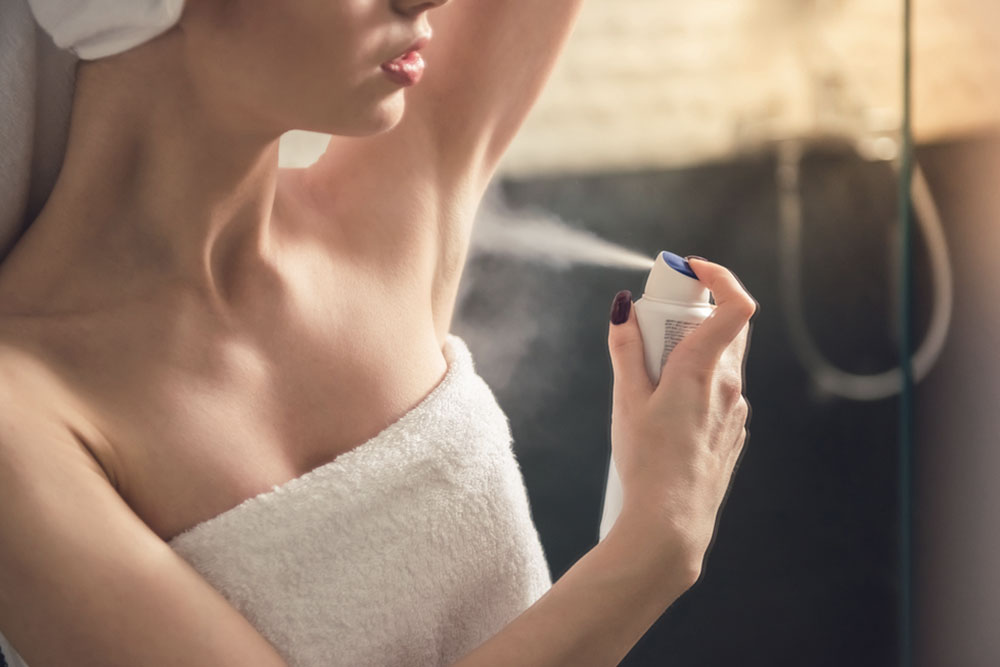Deodorants and antiperspirants – Types, benefits, risks, and more
Both deodorants and antiperspirants decrease body odor, but in different ways. Deodorants increase the skin’s acidity or pH levels, while antiperspirants reduce sweat production to keep you fresh. Although most antiperspirants are also deodorants, the reverse is not true. This post takes a closer look at the differences between the two odor-control products. It also discusses their types, advantages, and risks and lists a couple of popular options for men and women.
Deodorants vs. antiperspirants
Although many use the terms deodorants and antiperspirants interchangeably, they are not the same. Here are a few factors that differentiate the two:
- Deodorants lessen odor, whereas antiperspirants lessen perspiration.
- Deodorants can be used on the feet and other body parts, whereas antiperspirants are usually applied to the underarm region.
- Deodorants have antibacterial substances like triclosan and triclocarban, quaternary ammonium compounds, and fragrances. Antiperspirants have aluminum or another metal that prevents sweat ducts from releasing moisture.
Both deodorants and antiperspirants are marketed as liquid roll-ons, solid sticks, or spray products and are meant to be applied to intact skin.
Types of deodorants
Numerous types of deodorants are available in the market, and you must discover what suits you best. Some have an overtly strong fragrance, while others might not. The popular types include:
- Aerosol
Aerosols or sprays are sought-after because they do not leave behind any white residue on the skin that can discolor your clothes. They also dry out faster. You can use them on any area that requires scent control, like those occasionally stinky feet. - Roll-ons
These come in bottles with a scented liquid and a plastic rollerball applicator. Although roll-ons are simple to use and provide effective odor prevention, they can initially feel cold and wet on the skin. - Gels
Gels are thick liquids, which means they take longer to dry out after application. Nevertheless, they do a great job of preventing body odor. Aluminum is the most common component in conventional gel deodorants, but how they feel on the skin differs from person to person. Their dense, jelly-like texture is due to the silicone-based polymer, dimethicone. Gels typically do not leave residue on your skin or clothes. - Solid
These are one of the most effective options. Solid deodorants come in the form of sticks and bars and dry out easily when applied. However, they might leave a residue on your clothes, particularly on dark-colored outfits. Invisible solid deodorants are also available, which have a similar powdery texture but prevent staining of clothes. - Homemade
If you do not like the products in the market, try making your own DIY deodorant and antiperspirant. Experiment with various bases, powders, and oils. Shea butter, cocoa butter, and coconut oil work well as a foundation, but you do not have to add these in all-powder recipes.
Benefits of deodorants and antiperspirants
These products have many advantages, some of which are summarized in the following points:
- Antiperspirants halt odor-causing sweat. They block the sweat glands for 12 to 24 hours before they open naturally, requiring reapplication.
- Since antiperspirants require FDA approval, you can be sure they are harmless.
- Deodorants kill the odor caused due to sweat and provide a fresh fragrance, which is one of the most appreciated benefits.
- Although not a strict rule, many deodorants use natural ingredients, preventing skin irritation.
Risks of using deodorants and antiperspirants
While these products have numerous benefits, they must be used cautiously due the following reasons:
- As discussed, antiperspirants use aluminum to block sweat glands. Some experts believe that applying such products to the underarm region can increase the risk of breast cancer. However, more research is required to establish this theory.
- Traditional antiperspirants sometimes use several components that are usually not advisable, including endocrine-disrupting additives and sensitizing petrochemicals like parabens.
Popular options
Many brands sell odor-control products, making it hard to choose. Here are two popular options to consider:
- Tom’s of Maine Charcoal Antiperspirant
Tom’s of Maine Charcoal Antiperspirant contains kernel oil to keep the skin soft and moisturized. It also has activated charcoal to keep your underarms dry. One swipe is sufficient to prevent armpit perspiration all day! The product is free of petrochemicals and artificial fragrances. It is a popular choice for people looking for deodorants and antiperspirants for men. - Dove Dry Spray Go Fresh Antiperspirant
Dove is known for antiperspirants with one-quarter moisturizing benefits, and Dove Dry Spray Go is one of them. This product leaves your skin feeling incredibly smooth despite being a drying agent. The refreshing smell of juicy pears, jasmine, and freesia flowers makes it a great deodorant and antiperspirant for women.

